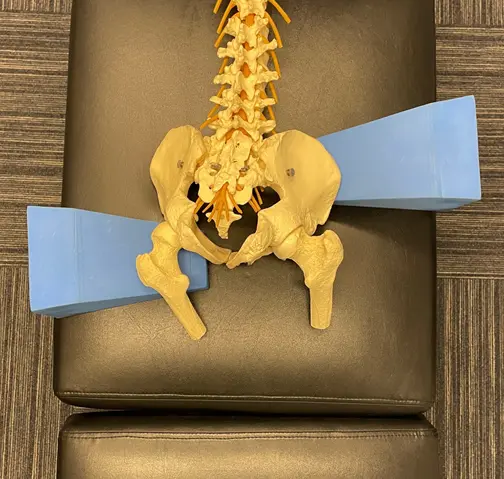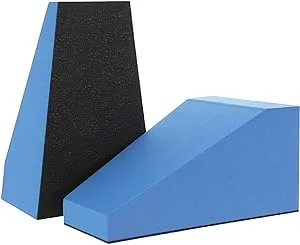This article will explain how to use pelvic blocks to relieve SI pain. Pelvic blocks are a simple yet effective tool that Denver Chiropractors and physical therapists use to relieve SI pain. If you are struggling with SI pain, pelvic blocks can bring you relief. They are typically made of foam or wood and are strategically placed under the pelvis to provide support and stability. When properly placed, pelvic blocks help to align the sacroiliac joint. The Sacroiliac joints can become misaligned and “stuck”, due to injury, pregnancy, or prolonged sitting.
When the sacroiliac joint is misaligned, it can cause pain and discomfort in the lower back, hips, buttocks, and sciatic nerve. Chiropractic blocks work by gently realigning the joint, reducing inflammation, and relieving pressure on surrounding muscles and nerves.
Whether you’re an athlete recovering from a sports injury or an individual experiencing chronic SI pain, pelvic blocks offer a safe and drug-free option to help you regain mobility and find balance in your body. Join us as we delve into the benefits of pelvic blocks and how they can be incorporated into your pain management routine.
Table of Contents
ToggleUnderstanding SI Pain and Its Impact on Daily Life
SI pain, or sacroiliac joint pain, can significantly impact an individual’s daily life. This pain is often felt in the lower back, buttocks, and hips and can vary from mild discomfort to severe pain. It is also typically worse on one side or the other. It can be caused by a variety of factors, including trauma, pregnancy, arthritis, or repetitive stress on the joints.
Living with SI pain can limit mobility, affect posture, and even lead to emotional distress. Simple tasks like walking, sitting, or standing for extended periods can become challenging and painful. Fortunately, pelvic blocks offer a potential solution for individuals suffering from SI pain, providing relief and restoring balance to the body.
What are Pelvic Blocks and How Do They Work?
Pelvic blocks are specially designed wedges placed under the pelvis to provide support and alignment. They come in various shapes, sizes, and materials, such as foam or wood. The goal of using pelvic blocks is to realign the sacroiliac joint, gently reducing pain and inflammation.
When the sacroiliac joint is misaligned, it can strain the surrounding muscles, ligaments, and nerves, leading to pain and discomfort. By elevating the pelvis, pelvic blocks help restore proper alignment, relieving pressure on the joint and facilitating the healing process.
The benefits of using pelvic blocks for SI pain relief
Using pelvic blocks for SI pain relief offers numerous benefits. Firstly, they provide a non-invasive and drug-free option for managing pain. Many prefer this approach, as it avoids potential side effects associated with medications or invasive procedures.
Pelvic blocks also offer immediate relief by reducing pressure on the sacroiliac joint and alleviating pain in the lower back, hips, and buttocks. Combining chiropractic care, core strengthening, and stretching is a great way to relieve SI pain. Moreover, pelvic blocks are portable and easy to use. They can be used at home, in the office, or while traveling, making them convenient for individuals seeking continuous pain relief throughout the day.
Types of pelvic blocks available in the market
Several types of pelvic blocks are available, each offering unique features and benefits. Foam pelvic blocks are lightweight, affordable, and provide a comfortable surface for support. Many a Denver chiropractor uses pelvic blocking to treat mild to severe SI pain. The same blocks our Denver chiropractor uses at Integrative Health and Rehabilitation can be purchased on Amazon.
On the other hand, wooden pelvic blocks offer a firmer and more stable surface for support. They are designed to withstand greater weight and provide enhanced stability, making them suitable for athletes and individuals with chronic SI pain. However, wooden blocks can be more uncomfortable to lay on than foam blocks.

How to Place Pelvic Blocks for SI Pain Relief
If you are wondering how to use pelvic sacral blocks, placing pelvic blocks for SI pain relief requires proper positioning and technique. It is essential to consult with a chiropractor in Denver to ensure the correct pelvic blocking technique and usage and maximize the benefits.
To use pelvic blocks:
- Proper pelvic blocking technique requires you to determine where your SI pain is located. Is it near the waist or “belt line,” or is it further down, near the center of your buttocks? You may notice the pain in different areas on the right side than on the left.
- If you are alone, lying flat on your stomach on a firm surface, take a moment to focus on where your pelvic pain is. If the pain is worse near the belt line or waist, place one pelvic block under that side of your pelvis at the waistline (The right side, on the picture above). The narrow part of the block should point toward the midline of your body. Secondly, place the other block on the opposite side, underneath the ischial tuberosity (your sit bone). Again, place the narrow side pointing toward your sacrum (In the picture above).
- If you have someone who can help you, have them compare leg length while you are lying flat on a bed or the floor. Place the block on the “short leg” closer to your waist and the other block lower down on the opposite side (see picture above; “short leg” is on the left). Correctly placed blocks will create even leg length. If the blocks are in the right position, your pain should improve after a few minutes.
- Take a moment to adjust the block’s position until you feel comfortable and supported. Use the blocks several times a week for best results until you begin to get relief. It can take some time to lay comfortably for more than a few minutes. Icing or using a TENS unit on the lower back while lying on the blocks can provide faster relief.
- Start with shorter durations and gradually increase the time as your body adjusts. If your pain worsens or begins to radiate outward from the SI, up the spine, or down the leg, schedule an appointment with our office right away so we can determine the real cause of your pain. Applying ice or a cold pack to the SI joints will also provide relief.
Tips for Using Pelvic Blocks in Your Daily Routine
Using pelvic blocks in your daily routine can provide fast SI pain relief. If you have searched “pelvic sacral blocks how to use,” here are some tips to help you use your pelvic blocks properly:
1. Start with short sessions: Use the blocks for a few minutes and gradually increase the duration as you become accustomed to the support.
2. Consistency is key: Aim to incorporate pelvic block sessions into your daily routine, whether in the morning, during breaks at work, or before bedtime. Consistency allows your body to adapt and benefit from the therapeutic effects of the blocks.
3. Combine with other therapies: Pelvic blocking can be used with other treatments such as stretching, yoga, and Chiropractic. If you have questions or are not getting relief from your back pain using pelvic blocks, schedule a FREE consultation with one of our Doctors to determine what is causing your SI pain and find out how to fix it!
4. Listen to your body: Pay attention to how your body responds to using pelvic blocks. If you experience discomfort or pain, email us or schedule a quick visit to ensure proper usage and adjustment.
Other Complementary Therapies for Relieving SI Pain
While pelvic blocking offers effective relief for SI pain, incorporating complementary therapies can further enhance the overall management of this condition. Accordingly, here are some additional therapies to consider include:
1. Acupuncture: Acupuncture (and Dry Needling) can relieve SI pain in many ways. Needling “tight” muscles helps reduce spasms and interrupt pain signals (the Gate Theory of Pain Control). These therapies also reduce inflammation.
2. Chiropractic: We specialize in improving spinal function and can perform adjustments to restore motion to”stuck” SI joints. We will also provide exercises and lifestyle modifications to help prevent SI pain in the future. Contact Integrative Health and Rehabilitation to schedule a free consultation with a chiropractor in Denver to assess your SI pain.
3. Laser Therapy: Low-level light therapy (cold laser) is helpful for many injuries and conditions, including headaches, plantar fasciitis, and knee pain.
4. Hot and cold therapy: Applying heat or cold packs to the affected area can also help reduce inflammation and relieve temporary pain. Alternate between heat and cold therapy to find what works best for you.
5. Shockwave Therapy: Shockwave therapy in Denver is an effective, painless treatment that relieves swelling and improves joint function. Shockwave therapy is one of the newest and most effective treatments for soft tissue injuries.
Finding Balance and Relief With Pelvic Blocks
Pelvic blocking offers a non-invasive and drug-free solution for individuals seeking relief from SI pain. By aligning the pelvis, these simple yet effective tools can alleviate pain, reduce inflammation, and restore balance to the body. With patience, consistency, and pelvic block support, you can find balance and relief, reclaim mobility, and enjoy a pain-free life. Get your own Pelvic Block set on Amazon.
When used correctly and consistently, pelvic blocking can be valuable to your pain management routine. Whether you’re an athlete recovering from a sports injury or an older individual experiencing chronic SI pain, consider incorporating pelvic blocks into your daily life and experience the transformative benefits they offer.
Lastly, learn more about the conditions we treat and the benefits of the many types of treatment we provide on our Health Articles page. Need help managing back pain, neck pain, or headaches? Stop Googling “Chiropractor Denver” and schedule a Free Consultation at our affordable Chiropractic office. We will give you honest answers to what is causing your pain and how Acupuncture, Chiropractic Adjustment, Dry Needling, or Shockwave Therapy will help your specific problem! Still not sure if we can help? Please read some of our 5-Star reviews and see what patients say. We’ve been helping patients in Arvada, Denver, and Wheat Ridge, Colorado, for over 20 years.

Ready for an expert opinion? Get in touch today!
With a legacy of more than 25 years, our team specializes in helping individuals triumph over back pain, neck discomfort, and persistent headaches, all without relying on addictive medications or risky surgical procedures.








